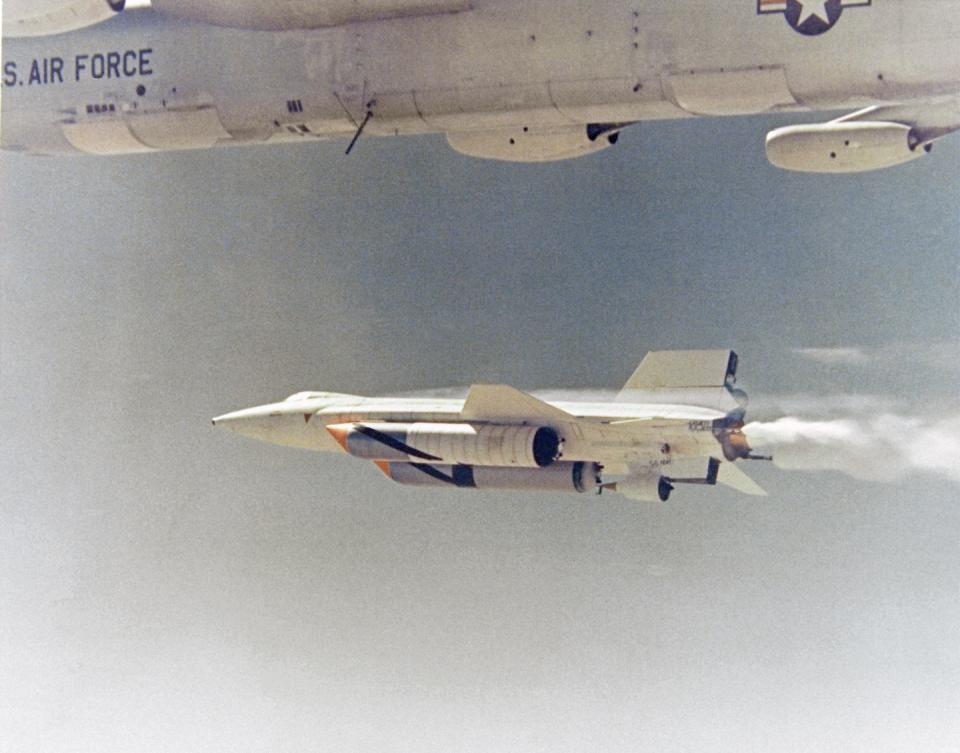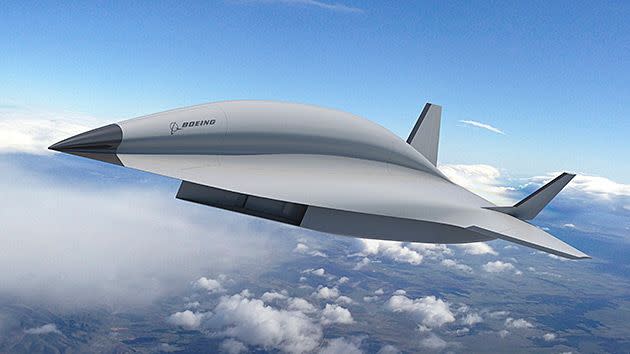60 Years Ago, the First Human to Reach Space Also Became the First Human to Travel at Hypersonic Speeds
- Oops!Something went wrong.Please try again later.
On April 12, 1961, the Soviet cosmonaut Yuri Gagarin became the first person to safely reach space and orbit Earth.
During his historic journey, Gagarin set another record, becoming the first human to travel at hypersonic speeds.
Gagarin’s flight marked a pivotal moment in the quest for hypersonic travel.
Sixty years ago this week, Soviet cosmonaut Yuri Gagarin became the first person to pierce Earth’s atmosphere and safely reach space. Gagarin spent 108 minutes strapped into his Vostok 1 spacecraft before returning to Earth as a hero.
But during his incredible journey on April 12, 1961, Gagarin also set another record when he became the first person to experience hypersonic flight.
✈ You love badass planes. So do we. Let’s nerd out over them together.
For an object to reach supersonic speeds, it must exceed the speed of sound, or Mach 1. The speed of sound, however, can change depending on the composition and temperature of the air through which the sound or object is traveling. Because the air is thinner and colder higher up in Earth’s atmosphere, the speed requirements to break this barrier at altitude are lower than they are at sea level.
Legendary test pilot and U.S. Air Force Major Chuck Yeager became the first person to reach this milestone when, in 1947, he piloted his Bell X-1 research plane to 45,000 feet above Earth’s surface, broke the local sound barrier, and reached top speeds of 700 miles per hour (mph), or Mach 1.06.
Only a few skilled pilots have traveled at hypersonic speeds—speeds reaching about five times the speed of sound. But much of the physics of hypersonic flight is still a mystery.
As a vehicle travels faster and faster past speed of sound, it generates a series of pressure waves. These pressure waves bunch up—imagine a pressure wave traffic jam—and form a shockwave that surrounds the aircraft, Javier Urzay, a senior researcher at the Center for Turbulence Research at Stanford University, tells Pop Mech. When the speed of a vehicle increases, the pressure and temperature of gas molecules in the immediate vicinity of the vehicle increase rapidly.

For aircraft traveling at supersonic speeds, forces like drag are the primary concern. But when an aircraft reaches hypersonic speeds, heat becomes the main focus.
“We don’t know how to estimate those thermal mechanical loads because we don’t understand the fundamental physical aspects of all the flow around aircraft at those high speeds,” Urzay says.
Furthermore, it takes a lot of computational power to make these estimates.
On his way back to Earth’s surface, Gagarin and his Vostok 1 capsule reportedly reached hypersonic speeds. A month later, Alan Shepard became the first American to experience hypersonic speeds, when his capsule surpassed Mach 5 during reentry into Earth’s atmosphere.
The record for fastest-ever human travel, for what it’s worth, goes to the Apollo 10 crew, who in 1969 reached speeds of nearly 25,000 mph, or 30 times the speed of sound, as they free fell through Earth’s atmosphere. Technically, these weren’t controlled flights.
Six years after Gagarin’s famed flight, U.S. Air Force Major William J. Knight earned the title of “fastest man on Earth” when he piloted his North American X-15A-2 research rocket plane to speeds of Mach 6.7, or 4,520 mph. Dropped from the belly of a B-52 at an altitude of around 45,000 feet, the airplane roared to life, kicking off the roughly 8-minute powered portion of the flight.

The exterior of the X-15A-2—which was designed specifically to withstand high temperatures, decreased stability, and the intense forces exerted during high-speed travel— was covered in a nickel-chrome alloy coating that acted as a heat sink and kept the aircraft from getting too hot during its flight.
Between 1959 and 1968, 12 pilots conducted almost 200 test flights, all of which helped scientists and engineers understand the perils of hypersonic flight.
To this day, no controlled, human-piloted aircraft has ever surpassed Knight’s record.
And then there are uncrewed flights. A two-staged rocket called Project Bumper became the first to achieve hypersonic flight in 1949. The second stage of a V-2 sounding rocket reached Mach 6.7 when it launched from the New Mexico desert that same year. In 2004, NASA’s uncrewed X-43A set the record for fastest jet-powered flight when it briefly reached speeds of Mach 9.6, or about 6,363 mph, before slamming into the ocean.
In recent years, the U.S., China, Russia, and other countries have raced to develop plans for a variety of hypersonic weapons, from ballistic missiles like China’s WU-14 missile to specialized aircraft like Boeing’s hypersonic spy drone.
Urzay says we may have to wait a while for hypersonic commercial flights designed to ferry hundreds of passengers well past the Mach 5 boundary. Still, manufacturers like Boeing are working on concept planes that take off using regular turbofan engines but rely on ramjets, a type of air-breathing engine that uses a plane’s forward motion to compress air, to reach top speeds.
But don’t bother saving up your miles just yet. “We have a very small understanding of the fundamental physical processes that happen in the gaseous atmosphere around the aircraft at high Mach numbers,” says Urzay. “Those challenges still remain after 60 years.”
🎥 Now Watch This:
You Might Also Like
